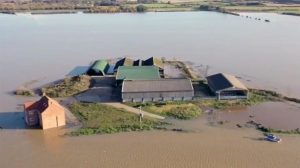Flooding is becoming an increasingly urgent environmental issue, both in busy urban areas and suburban environments.
When it comes to new and existing developments, flood risk is becoming more of a concern than ever. According to a report by DEFRA, an estimated 3.2 million households in England are located in areas at risk of surface water flooding.
While it does pose a challenge, there are things we can do to dramatically reduce and even prevent flooding in the future.
This week, therefore, the Rennard Consulting blog is exploring why flooding continues to pose a challenge and how we, as professionals, can overcome them using innovative solutions.
Why is flood risk becoming such an issue?
When it comes to solving a problem, it’s worth knowing what you’re up against.
Although flood risk is a complex issue, there are generally three primary reasons our risk of flooding is increasing.
Our growing population
We’ve known for some time that the global population is increasing year on year, and our towns, cities, and suburban areas will need to expand to accommodate them.
With that expansion comes a growing demand for, and reliance on reliable, drainage systems.
Take the Abbey Mills pumping station in London, for example. Designed 150 years ago by Sir Joseph Bazalgette, the station is part of a large network of sewers that served four million people in the 19th century. The River Thames would accommodate overflow sewage maybe once a year to avoid flooding residential spaces.
Today, the population of London hovers around 9.5 million. Its streets are paved with impermeable surfaces such as tarmac, and the sewers now overflow into the Thames roughly once a week.
Furthermore, as urban expansion continues and impermeable surfaces are installed as a consequence, the speed and velocity of water flow increases. Rainfall isn’t absorbed into the earth because it cannot permeate material like tarmac. Instead, it runs off into our water systems far more quickly and in higher volumes than those systems are designed to handle.
While an increasing demand for new developments and homes is great news for many across the development industries, without sustainable, future-proof drainage solutions the risk of flooding will only increase.
Increased rainfall
Due to the effects of climate change, rainfall is steadily increasing, putting more pressure on developments to manage water run-off with better drainage.
Surface water flooding is already a widespread challenge. It occurs when the volume and speed of rainwater landing on the earth overwhelms the existing sewage networks – the water simply cannot drain away quickly enough.

According to the United Nations Environment Programme (UNEP), extreme flooding will continue to affect floodplains or low-lying coastal regions (unfortunately, that represents a significant area of the UK). As global warming increases the likelihood for more extreme weather events, risks will expand beyond the high-risk areas known today.
Despite these concerns, the Committee on Climate Change expressed in their 2017 report that there was ‘little confidence that high quality sustainable drainage systems are being built in the majority of new developments’.
Existing systems reaching capacity
Many existing urban drainage systems contribute to increased flood risk, and there’s one simple reason: they are at capacity.
Much like the Abbey Mills pumping station mentioned above, many current drainage systems and sewage networks were simply not built to move and store the amount of water needed in 2021 and beyond.
Built-up urban areas need to be drained effectively to remove surface water run-off. This has traditionally been achieved using underground pipe systems, conveying the water away as quickly as possible.

Existing drainage systems were built to solve the problems of that time. Elements like weather conditions, population, and surrounding environments have all changed; what solved the problem yesterday is, in some cases, exacerbating flood risk today.
So how do we address and solve problems like these?
Slowing the flow with SuDS
Sustainable drainage, known as SuDS, is an exciting approach to drainage. Rather than regarding water runoff as a nuisance to be transported off-site, SuDS manages rainfall close to where it lands and even puts it to good use in the meantime.
SuDS mimics nature’s existing water management system. It reduces the risk of flooding by transporting surface water at a sustainable pace until it enters engineered watercourses. From there water is stored in natural contours, allowing it to soak into the ground or evaporate from the earth or surrounding vegetation.
From a development perspective, SuDS also looks great and improves the quality of a space.
Basically, there’s no need to develop costly, complex sewage systems that transport water away from the site, and as a result there’s less opportunity for these systems to become overwhelmed or redundant.
Retrofitting existing drainage solutions
You don’t have to build something from scratch to prevent flooding on your site.
Drainage solutions like SuDS can be retrofitted to reduce the pressure on existing systems. SuDS can provide a more flexible approach, meaning you can design a drainage solution within the unique opportunities and constraints of any site, even in large built-up areas.
Look no further than Llanelli in South Wales. An old coastal town, Llanelli’s insufficient combined sewage system had led to continual flooding of property and residential areas.
After rejecting the traditional approach of building extra storage (priced at £377m), Welsh Water discovered they could dramatically reduce flooding for a quarter of the price using SuDS techniques.
The project entailed relatively small-scale changes, including roadside swales and planters. Using scientific models and new data, project leaders have predicted a sharp downturn in flood rates.
Christopher Ellis, one of the specialists overseeing the project, reported that: “Post-construction monitoring indicates [that] an additional 25 per cent reduction in peak flow has been achieved during some storms.”
It’s not the only one of its kind and in 2016, ten similar schemes had already cut sewer overflows by nearly 40 per cent. Ellis went on to say that, “the successful implementation […] has drawn the attention of many stakeholders throughout the UK and abroad.”
Design drainage that’s built to exceed expectations
Heavy or extreme rainfall will sometimes also overwhelm sewers and other drainage systems. Planning for exceedance and identifying where water will flow should a system become inundated is one way of managing risk and preventing disruption to a site.
Underground conveyance cannot be built large enough to accommodate extreme rainfall – it’s simply not possible economically or logistically. But there are approaches that can be taken to effectively drain surface water run-off from extreme rainfall events.

To do this, you need effective above-ground conveyance, flood pathways and flood routing. This might look like varying kerb heights, traffic calming measures, and property threshold details. When used properly, they can all contribute to reducing flood risk.
The challenge, of course, is executing these very careful design features and relying on inter-industry stakeholder engagement.
Why risk a flood when the right solutions are out there?
Designing, developing and building new spaces is never easy. There’s always an unforeseen factor or challenge to overcome, but flood risk does not need to be one of them.
And while the future of flooding might look unsettling, there are solutions being developed that take our rapidly changing world into consideration.
While the Abbey Mills pumping station is no longer enough to sustain London’s drainage needs, the Thames Tideway Tunnel is a major new sewer system that’s designed with a 22nd century city in mind.
By planning ahead or retrofitting a solution to an existing problem, you can ensure that your site offers its users and residents a significantly reduced risk of flooding.
Reference
- First the heat, then the rain: The problem of surface water flooding in England, by Committee on Climate Change
- ‘Surface Water Management: An Action Plan (July 2018)’, by The Department for the Environment, Food and Rural Affairs (DEFRA)
- London, UK Metro Area Population 1950-2021, by Macro Trends
- Flood Map, by Friends of the Earth
- ‘Progress in preparing for climate change 2017 – Report to Parliament’ by Committee on Climate Change, June 2017
- Sustainable drainage, by Susdrain
- Urban drainage, by Susdrain
- How climate change is making record-breaking floods the new normal, by United Nations Environment Programme (UNEP)
- How ‘Suds’ are being retrofitted to a whole town, by the Institute of Civil Engineers
- Background to drainage exceedance, by Susdrain
- Managing exceedance, by Susdrain
- ‘An Introduction to Sustainable Drainage Systems (SuDS)’ by The Flood Hub